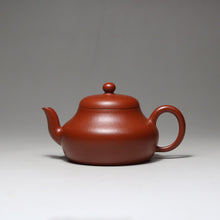
Every tea person needs to have a good teapot. It is orthodox and classic. It is not only practical and easy to brew, but also dignified and elegant. Today, this all-handmade small coal kiln Zhu Ni Jun De carved teapot is such an existence. An all-handmade pot is not only red, bright and delicate, full and agile, but also the hand-carved bamboo at the bottom of the pot makes this pot unique and enhances its collection value. In order to present the overall charm of this pot, the choice of mud is natural It is very particular that this pot is fired in a small coal kiln called Zhu Ni, which is known as the "Queen of Zhu Ni". The embryo yield is less than 50%. Although the firing is difficult, the molding effect is amazing. The finished mud is red and elegant, the pot surface is smooth and smooth, and the surface is a layer of light water ripples that stretch longitudinally and slightly soaked. It can present a lustrous and delicate Baoguang texture. This Jun De teapot is simple and generous, with a distinct personality. The processing of the line and surface has achieved "even, firm, round and positive", which is both practical and beautiful, making people look more and more The more I like it, "Jun De" is a compliment to a person of noble character. This pot contains humanistic virtues, high character, and the pot body is big belly. The design of this pot adopts the legacy of the Ming and Qing Dynasties, which is eye-catching. The overall shape of the pot is dignified and stable, the curve is beautiful and smooth, and the spirit is agile. If Mount Tai is plump and smooth, the round bead buttons are cute and playful, the ring handle is generous and natural, easy to carry the pot, the three bends face the sky, the water flows smoothly, the water is cut off neatly, the pot body has a large space, which is conducive to the stretching of the tea leaves, suitable for oolong tea, Pu'er tea, white tea , Tea with a relatively large strip shape, a capacity of 100cc, and pure hand-carved painting. It is a common art form for Zisha teapots. The traditional Chinese elements are presented on the teapot, which makes the teapot more literate and artistic, and enhances the aesthetics and collection of the teapot. The bottom of this Jun De teapot is engraved with a bamboo pattern, the knife is messy but not messy, the bamboo bones are strong and powerful, and the bamboo leaves are free, criss-cross, and dense. Several pens are entwined, and the inside of the lid, the bottom of the pot and the bottom of the pot are clearly signed by the author and the collection certificate, which is convenient for tea lovers to play and collect.

















